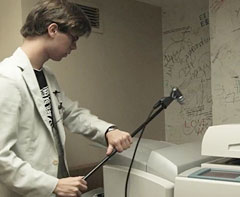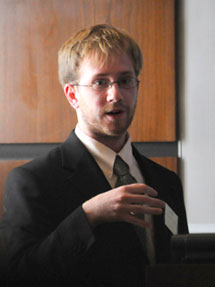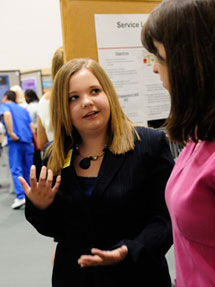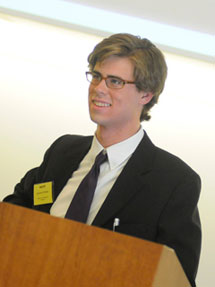Research Fair Spotlights Student Discoveries
By Claire L. Burgess
 |
Harry Miree captured the sounds of more than 50 copy machines for his latest project. To see how he turned those sounds into a cohesive tune click here. |
You don’t have to have a doctorate—or even a college degree—to work on groundbreaking research at UAB. At a time when most freshmen are still trying to find the dining hall, Ashleigh Allgood was digging up fresh insights as part of a horticultural therapy research project. Junior Nathan Renneboog followed his interest in epidemiology into outer space. And senior Jennifer Ghandhi traveled to Florence, Italy, to present her research on happiness and health.
Those projects and many more were featured at the second annual UAB Expo. According to Christopher Reaves, Ph.D., director of UAB’s Office for Undergraduate Research and the event’s creator, the Expo does more than give students the opportunity to showcase their research and field work. Undergraduates can network with faculty members and other students as they explain their projects, respond to questions, and garner feedback, Reaves says. The whole experience helps deepen the understanding of their work and gives them valuable public-speaking experience, he explains, which is a mainstay of graduate education and professional life.
“It’s really about student learning,” Reaves continues. “Having applied experience, getting your hands dirty, going out in the field, going into the lab: This event is a culmination and a showcase of that.”
The Expo is not simply a celebration of laboratory study, either. The 140 students presenting their work last year represented more than 30 majors. The eclectic range of poster and oral presentations covered subjects from microbiology to German Expressionism to Birmingham housing patterns. UAB Magazine spoke with three students about the projects they presented.
Nathan Renneboog: Fighting a virus via satellite
Ashleigh Allgood: Planting the seeds of therapy
Harry Miree: Conducting an office orchestra
Nathan Renneboog: Fighting a Virus Via Satellite
 |
Nathan Renneboog is part of a team that uses satellites to track the spread of West Nile virus. |
Nathan Renneboog is something of a space detective. He leads a team of undergraduate and graduate students that uses satellites—or remote sensing technology—to track the spread of West Nile virus. Renneboog became interested in the subject when he was introduced to UAB’s Laboratory for Global Health Observation through the Science and Technology Honors Program. Soon he was participating in NASA’s Develop internship, analyzing satellite images with his research team.
UAB Magazine: Tell us about your research.
Renneboog: I’ve been using spatial analysis and remote sensing to detect high-risk zones for West Nile virus. We’ve been looking at mosquito habitats, and the interesting thing about that is that it applies to other diseases such as malaria, or really anything that’s carried by mosquitoes.
UAB Magazine: Why are satellites a good tool for this research?
Renneboog: Humans only see the visible light range in the electromagnetic spectrum, but satellite imagery can pick up information from the near infrared and other parts of the electromagnetic spectrum, and that can be really helpful. For example, vegetation is most heavily reflected in the near infrared part of the spectrum. So we use that part of the satellite imagery when we make a map to show different levels of vegetation. It produces better results than if we were just using the visible light range. In addition, satellite imagery allows researchers to study large areas at one time, giving them a huge advantage.
UAB Magazine: How do you locate mosquito breeding sites?
Renneboog: We first obtain the satellite imagery from NASA, and then apply a formula to every pixel in the image to make a map that represents the different levels of vegetation in the study area. That can be significant because the number of mosquitoes may depend on how much vegetation there is. We also obtain digital elevation maps from the U.S. Geological Survey, because elevation often positively correlates to numbers of mosquitoes. And we combine that with other things such as precipitation and temperature data. We then run a number of statistical tests to determine which environmental variables correlate positively with the mosquito data. Then we make a map showing the expected abundance of the mosquitoes over the whole study site. We want to see what type of environmental factors we are finding in the places with high mosquito counts.
UAB Magazine: What do you plan to do with your findings?
Renneboog: We have presented our results to senior NASA executives, at local public health departments, and at the NASA Public Health Program Review. Our project also won first place at the UAB Public Health graduate research day. And we’re hoping that, in the long run, our research can be used to help local health departments focus their resources on high-risk areas and target pesticide spraying.
Ashleigh Allgood: Planting the Seeds of Therapy
 |
Ashleigh Algood explains how a little dirt under the nails can help reduce stress and improve motor skills. |
Most people have heard of art therapy, music therapy, and even pet therapy, but Ashleigh Allgood revealed the world of horticultural therapy in a poster presentation at the UAB Expo. The pre-health science major gained experience in the field during a service learning project at the Birmingham Botanical Gardens.
UAB Magazine: What is horticultural therapy?
Allgood: It’s putting therapy and flowers together. Different groups of people, from young kids to adults, get their hands in the flowers and the dirt and use the skills they don’t normally get to use. I worked with people with cerebral palsy who don’t really get to go outside very often. They helped us plant flowers, and it helped them with motor and cognitive skills—and their self-esteem. People were smiling after they were done, because they felt like they had done something good.
UAB Magazine: Were you interested in gardening before this?
Allgood: Oh, no—I didn’t think I could keep anything alive. But I heard that all you need is a little bit of water, and you’re pretty good. We planted daisies, petunias, and annuals. We made terrariums, which was extremely hard to do. I had a big glass jar, like a big jug, and I was sticking my arm way down into it, trying to put different plants and moss in it.
Even if you’re not interested in or have no earthly idea about gardening, you learn pretty quickly. And who doesn’t need to know how to do their lawn? Putting your hands in the dirt—I would always have to bring a file to get the dirt from underneath my fingernails afterward—was fun. You and the ground—there’s just something kind of magical about it. It’s kind of corny, but it’s there.
UAB Magazine: Was the experience therapeutic for you, too?
Allgood: Yes. I would get worried and stressed out with school, and then I would go to the gardens, and it’s a stress reliever. I got to see those people’s smiling faces. It was a humbling experience.
Harry Miree: Conducting an Office Orchestra
 |
Listen to Harry Miree's orchestra of copiers play the theme to Super Mario Brothers. |
For Harry Miree, practically anything has the potential to become a musical instrument. At the first UAB Expo, the music technology major presented a composition featuring the rhythmic sounds of a busy restaurant—the clanging of pots and pans, breaking glass, and yelling cooks. Last year, he premiered a piece using an orchestra of office copy machines.
UAB Magazine: How did you get the idea to make music with photocopiers?
Miree: A couple of months ago, I was making copies of music for a youth orchestra in town that I direct, and I noticed that the copy machine was humming at a nice, solid, E-flat pitch. And I thought, “That’s funny; my copy machine at home hums at an E.” And it dawned on me that there are copy machines all over the city humming at different pitches! I could put those together and make music out of them.I got a good reaction with my project at the first Expo, but sort of a blank one. I realized that the audience wasn’t really relating to the collection of kitchen rhythms I created. [To hear "Freddy's Kitchen" for yourself, click here.] With the copy machines, I thought an audience might better relate to music that they know. So I used the Super Mario Brothers [video game] theme song. It proves the point that I can do this with copy machines, and they understand the music coming out. I think that creating a piece all on my own might have enslaved me a little more to the copy machines. I might have said, “Well, I have A through E; I’m just going to use those pitches and come up with something within those confines.”
I thought that I could do something good with all 12 pitches in the traditional western scale. But because we have different octaves of these pitches, I actually used more than 50 copy machines. Some were producing the same pitches or producing quarter tones that weren’t part of the traditional western scale, so there was a lot of trial and error. I spent a good number of days chasing after copy machines.
UAB Magazine: How did you find them all?
Miree: I called as many people as I knew with copy machines and asked, “Can I drop by for five minutes and record?” I got into the habit of sticking a little microphone into the actual scanner, so I have hundreds of copies of my microphone.
UAB Magazine: How did you turn those noises into a composition?
Miree: It came down to sampling, actually. I would try to get as solid a signal as I could from each machine so I could just get the pitch. By using an audio sequencer, I could make it as short or as long as I wanted. So I found each pitch of this composition that I would need, and then found a copy machine that would relate to that pitch. Little by little, I pieced them together in the same way you’d paste together pre-existing words on a scrambled-up Microsoft Word document.
UAB Magazine: Will you continue this in the future?
Miree: I don’t want to get into a rut of re-creating popular songs with copy machines. That’s sort of a niche artistry. A friend of mine actually called me and said, “Dude, do the Blue Danube Waltz with copy machines.” And I thought, “Wow, this could get really out of control.” But I see a few avenues, and I trust by the next UAB Expo I’ll know what the next step is.